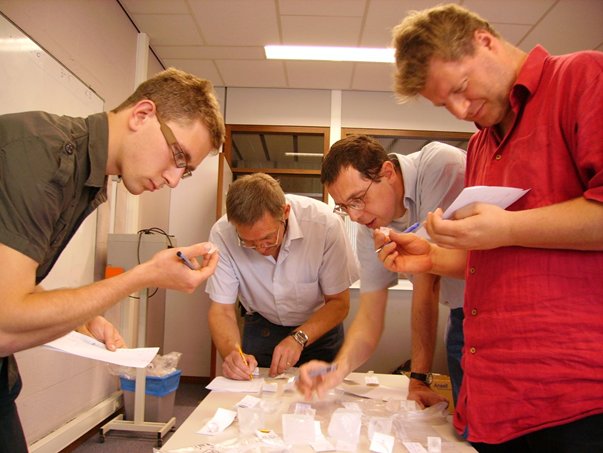How are the single crystals judged?
A single crystal can be judged on the basis of its quality or a combination of mass and quality. Judging criteria are given below. You can provide different categories, e.g. according to age, best quality, best school, longest crystal etc...
Judging criteria

Credit: picture by Dirk Poelman
The quality is judged by experts who will rank the crystals on a scale of 0 to 10. A score of 10 will be given to a perfect gem-quality crystal that fits the ideal crystal structure known for the chemical.
- The crystal is weighed, and the mass M recorded. It is possible to require a minimum mass, e.g. the crystal must be a minimum of 0.5 g to be eligible for judging.
- The quality of the crystal is judged on a scale of 1 to 10, with 10 representing a perfect crystal. The following factors will be considered in judging quality:
- match/mismatch with crystal type (out of 2)
- presence/absence of occlusions (out of 2)
- intact/broken edges (out of 2)
- well formed/misformed faces (out of 2)
- clarity/muddiness (out of 2)
Total Observed Quality Q = x.xx (out of 10)
- The Total Score is then determined as follows:
Total Score = [log (M+1)] x Q
The logarithm of the mass is chosen so that large poor quality crystals don’t swamp out smaller good quality crystals.
The value 1 is added to the mass so that crystals weighing less than 1 g get a positive score.
Overall score
Instead of using the Total Score to indicate the winning crystals, one can also take the amount of starting material into account.
A 100 per cent yield crystal made from 100 g (Mt) that scores a perfect 10 on quality (Qt) would get a theoretical maximum of:
[log (100+1)] x 10 = 20.01
The actual score can also be expressed as a percentage of the maximum. The crystal with the highest Overall Score is then the winning crystal.
100 x {[log (M+1)] x Q} / {[log (Mt+1)] x Qt} = Overall Score %
For example, the best overall crystal in the Canadian 2001 contest with 150 g starting material weighed 46.53 g and had a quality of 8.65. Its overall score was:
100 x {[log (46.53+1)] x 8.65} / {[log (150+1)] x 10} = 66.6%
This score is nearly an absolute score that could be used to judge different types of crystals grown from differing amounts of starting material.


